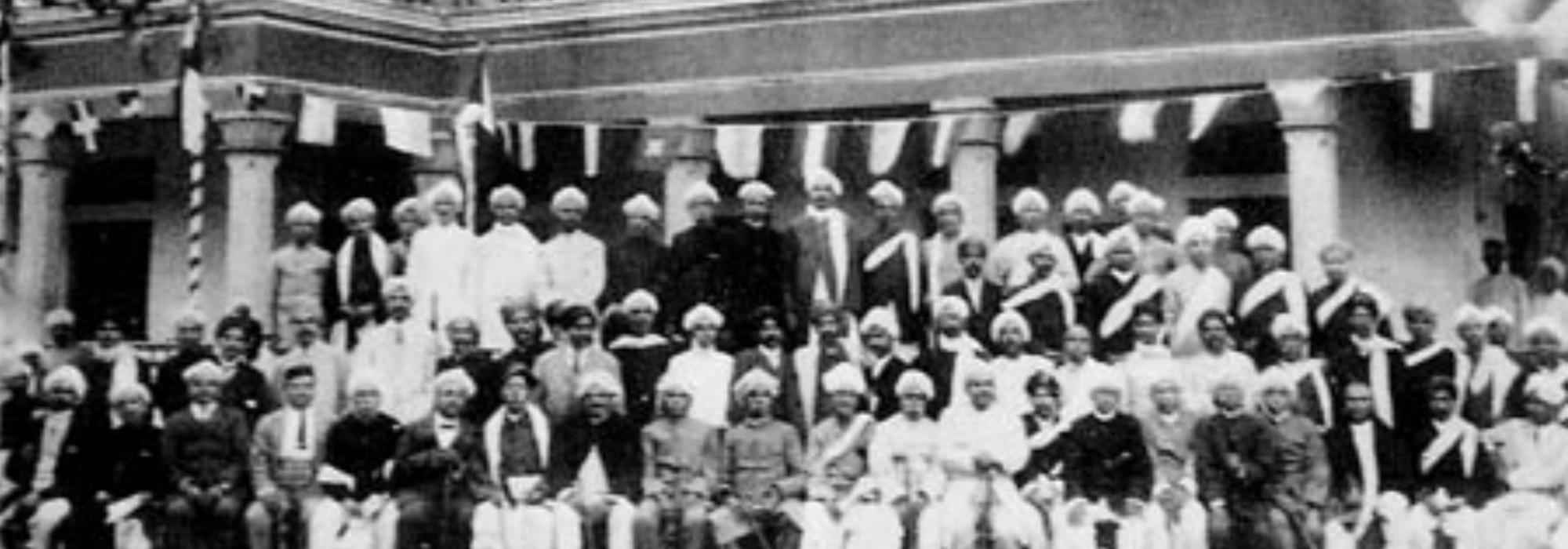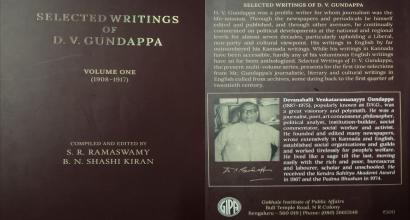Establishment of the Pariṣad
The Sāhitya Pariṣad was established in the assembly hall located in the quadrangle of today’s Arts and Science College building, which is opposite to Central College, Bangalore.
People of great eminence from various places of the Kannada region had gathered to attend the Pariṣad’s programme. Ramachandra Hanamantha Deshapande from Dharwad; Mudavidu Krishna Rao, Alur Venkata Rao, and Jathar of the Karnataka Printing Press were present. Advocate Timmakrishna Rao from Bellary, Rao Bahadur C Hanumantha Gowda from Hospet, Benagal Rama Rao from Madras, Muliya Timmappayya from Mangalore, Punganuru Raghavendracharya from Mysore, and many other scholars had graced the occasion. Around 150 to 200 people had come from places outside Bangalore. The locals Bangaloreans numbered around 300 to 400. All in all, it was a huge congregation. I don’t recollect B M Srikantaiah being present during the event. I heard that T S Venkannayya and A R Krishna Shastri were somewhere in the hall. I had not been introduced to them yet. They had not yet gained popularity during those days.
If my memory serves me right, the programme started at around nine in the morning. H V Nanjundaiah as the President delivered the commencement lecture. But, in English! Prof. Bellave Venkatanaranappa was sitting on one of the first four or five seats in the front row, opposite to the dais. I was right next to him. Nanjundaiah had just begun his speech in English and had only spoken a few words when Venkatanaranappa in a soft tone said, “Nonsense! [in English]. This is absolute nonsense [in English]. That’s all!” Nanjundaiah must have heard this. The left-side of his moustache went up. Those who knew him well recognized that as symbol of his smirk. Nanjundaiah concluded his lecture as though he had not heard Venkatanaranappa’s comment, told the gathering to reassemble there at half past two that afternoon, walked down the stage, and asked Venkatanaranappa who was standing near him, “Is there no other substitute for that [the word ‘nonsense’] in Kannada?” Venkatanaranappa laughed. He turned to me and asked, “How do you say ‘nonsense’ in Kannada?” I replied, “Well, ‘nonsense’ itself.” I couldn't think of anything at that moment. Nanjundaiah gave a short justification after that.
“The effort we’re putting in right now, it’s something that even those who do not understand Kannada should know. The government, which should grant funds to our Pariṣad, should be aware of it. The British residents who oversee the government should also be informed about it. We don’t lose anything by keeping them all informed of it. However little, it may be beneficial, will it not?”
~
From around half past two in the afternoon to six in the evening, lectures were delivered that day. Speeches about the glories of the Kannada region, the grandeur of the Kannada language, our earlier poets, the kind of literature necessary for our people, the Pariṣad’s relevance to the state, and various such topics, were delivered by scholars in a greatly embellished manner. Their exaggerated verbal jugglery and repetition of the same ideas irked and harrowed many people in the audience.
The second day again was full of lectures. What should this well-intentioned organization be named as? This was the subject of discussion. To begin with, the confusion was whether its first name should be ಕರ್ನಾಟಕ (karnāṭaka), ಕರ್ಣಾಟಕ (karṇāṭaka), or ಕನ್ನಡ (kannaḍa). Or ಕರಿನಾಡು (karināḍu) instead? Should it be ಕರ್ನಾಟ (karnāṭa) or ಕರ್ನಾಟಕ (karnāṭaka)? Or could it be ಕರ್ನಾಟಕೀ (karnāṭakī)? Thereafter the debate was whether it should be called ಪರಿಷತ್ (pariṣat), ಸಂಸತ್ (saṃsat), or ಪರಿಷದ (pariṣada), or ಸಂಸದ (saṃsad), or ಸಭಾ (sabhā)? When the congregation came together, Nanjundaiah said, “Now that we have lost two days in merely debating the name, let us, at least now, go ahead and do some work. Perhaps Raghunatha Rao, Raghavendracharya, or someone else among you can suggest a name, and I will open it for polling. Enough of speeches! If we don’t reach a consensus, we shall go for another round of polling and if that fails, we will vote once again. Let us follow this system.”
“There are many speakers still to talk, sir!” said someone from the audience.
“I know, I know. We’re all the same. A town full of talkers. But even work needs to happen, doesn’t it?” replied Nanjundaiah and got the work initiated.
List of Rules
That morning a sub-committee that was appointed to prepare a list of rules for running the organization [i.e. the organizational policy], handed over a draft version of the regulations. Karpura Srinivasa Rao, Dr. P S Achyuta Rao, M S Puttanna, Bapu Subba Rao, R Raghunatha Rao, T Lakshminarasimha Rao were part of that sub-committee; I too was among them.
On the third day, the rough draft of the policy came under the scrutiny of the assembly. There were scholarly discourses even on that. Many suggestions like ದಾತೃಗಳು (dātṛgaḻu), ಪದಾತೃಗಳು (pradātṛgaḻu), ಮಹಾಪ್ರದಾತೃಗಳು (mahāpradātṛgaḻu), ಆಶ್ರಯದಾತರು (āśrayadātaru), ಆಶ್ರಯಕರ್ತರು (āśrayakartaru), ಪೋಷಕರು (poṣakaru), and ಪರಿಪೋಷಕರು (paripoṣakaru) came from the order of scholars [perhaps about how to address donors]. There was a debate on whether it should be ‘dātṛ’ or ‘dātā’. If one recited the Śabdamaṇidarpaṇa, another would quote Śabdānuśāsana; if someone mentioned poetic usage (kāvya-prayoga), another would talk about its legal import (śāsana-prayoga). In this manner, the discussion and debates went on and on.
Nanjundaiah, who was mostly laughing, made bitterly critical remarks once in a while, and concluded the work on the third day at four in the afternoon.
One person who toiled from the beginning till the end in the process of the Pariṣad’s establishment was the Secretary, B Krishnappa, MA. His patience and professionalism were as commendable as his scholarship. This gentleman was the first Kannada Professor of Mysore University.
Recreational Gathering
For the recreation of the eminent people present that evening, a get-together had been arranged. It was in the premises of the Central College Students’ Hostel. Most of the delegates were lodging there.
After planning to organize this recreational get-together, I sought the help of my esteemed friend and secretary to the government, D M Narasingha Rao. If he could arrange for two deras (large tents), fifty tables, two hundred chairs, and four jamakhanas (thick floor mats made from cloth) to be loaned to us from the government’s warehouse, I told him I would take care of the necessary rent for it. “Why do you take so much trouble man? The hostel warden B Venkateshacharya can easily help you arrange all these!” he said.
“But I don’t know Venkateshacharya at all!”
“How difficult is that?” he asked and came along with me to meet Venkateshacharya. This is how I was introduced to the venerable Venkateshacharya. He supported us with all his heart and helped in every possible way. During the get-together, the violin maestro Puttappa gave a vocal recital. Everyone who heard him said that it was wonderful. After distribution of the Gandha Puṣpa, when everyone was getting ready to leave, Nanjundaiah called me aside separately and softly asked, “How much did you spend? If you have taken a lot of debt, tell me.”
M Shama Rao was also present there. He said, “Allow him. It’s the madness of youth!”
Guru-śiṣya paramparā (Lineage of Teachers and Students)
The most important people who built and developed the Pariṣad belonged to a guru-śiṣya paramparā. Prof. Venkatanaranappa was a disciple of Nangapuram Venkatesha Iyengar. B M Srikantaiah, Masti Venkatesha Iyengar, and M R Srinivasmurthy were all the students of Prof. Venkatanaranappa. T S Venkannayya and A R Krishnashastri were disciples of B M Srikantaiah. Their mutual admiration and strong connections were beneficial to the Pariṣad. They had several differences of opinions among themselves. Yet, their delicate, sensitive, and friendly tone of communicating the differences was the reason why no cracks or fissures surfaced. Except during debates, they would all be single-minded at all times. Everyone would sit together, chat together, share food and eat together, laugh heartily making fun of each other; they would get together and work in such a way that it would seem that only one person was behind the whole thing.
This is the pleasant face of it. There is an unpleasant face to it as well. Mysoreans are arrogant and revel in groupism. Some people accused them of building their own camps. When five or ten people work together, sometimes we get to hear a few words of jealousy and intolerance. But if the people in the field action share a genuine bond of friendship and are singularly focussed, they will be able to stand strong till the end and achieve the goal.
A special episode. On the second day after the Pariṣad’s inception, some issue cropped up between H V Nanjundaiah and M S Puttanna. Both of them were extremely capable of making prickly statements. Puttanna was enraged and he stormed out of the meeting. We could hear the clapping of his Poona sandals. Venkatanaranappa stood up and announced, “I’ll go and bring him back!”
Nanjundaiah said, “To bring back our Puttanna, isn’t it? You don’t go. I’ll go myself!”
Fifteen or twenty minutes later, after the meeting was dismissed, Nanjundaiah sat in a vehicle and went straight to Puttanna’s house.
The next day, Puttanna came to the meeting with a smiling face. It didn’t seem like something unusual had happened the previous evening. Everything was pleasant.
~
An incident that occurred during one of the conferences of our working committee is quite educative. The meeting had convened at six that evening. The first task was to mourn someone’s death. The first draft for it was thus: “This committee mourns the death of a brilliant patriot, scholar, a gifted poet, and a generous donor, _______.”
Following were the amendments concerning this draft:
- Instead of saying “…because he died” it can be “…because he expired.”
- “Since he passed away…”
- “Since he is kālādhīna – under the sway of Death (or Time)…”
- “Because he became daivādhīna – as per the will of Fate (or the Supreme)…”
- “Because he became one with the five elements of nature…”
A whole lot of debate. What does daivādhīna really mean? How can becoming one with the five elements (pañcatva) – earth, fire, water, air, and space – be appropriate? Shouldn’t it be called ‘emptiness’ (śūnyatva)? If someone became svargasta (gone to heaven), why should it be ‘mourned’ – shouldn't it be ‘celebrated’?
The debate grew incessantly as the clock struck half past six.
Another chain of amendments began. Instead of saying “This committee has mourned,” why not say:
- “The whole world is grieving…”
- “It’s a great loss for the region/state/country…”
- “Isn’t it true that it’s a great loss?
- “It is right to say that there has been a loss…”
- “Shall we all agree that there has been a loss?”
Thus the debate developed. Even after the clock struck seven there was no decision. People can now guess why meetings and conventions in our state aren’t achieving the desired impact.
Concluded.
This is the second part of a two-part English translation of the tenth essay in D V Gundappa’s Jnapakachitrashaale – Volume 3 – Sahityopasakaru. Thanks to Śatāvadhāni Dr. R Ganesh reviewing the translation. Edited by Hari Ravikumar.









































